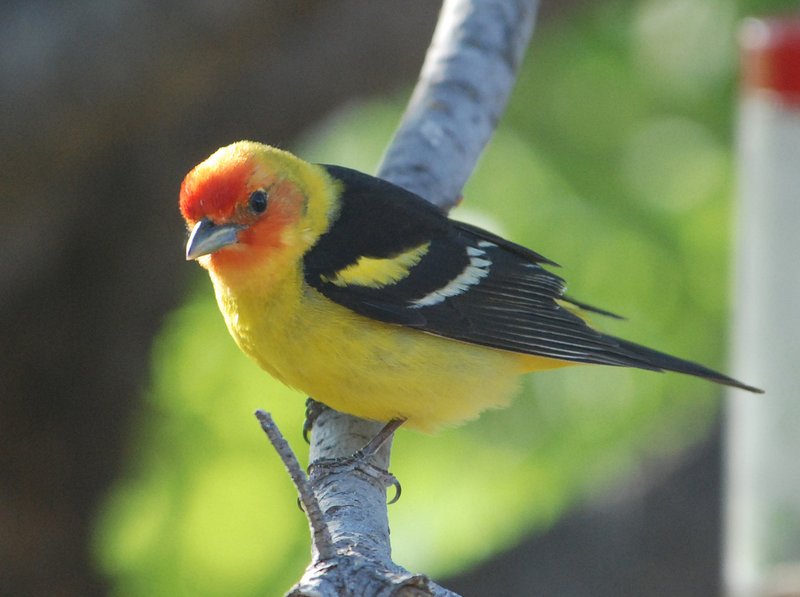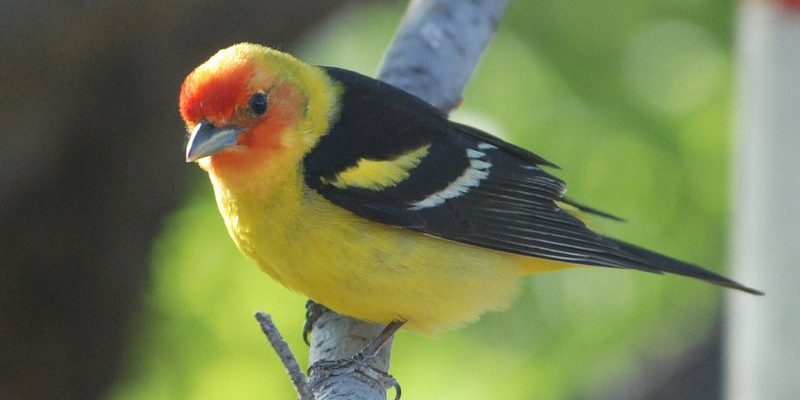
The Western Tanager is one of those birds that instantly catches your eye with its vivid colors and cheerful song. Imagine walking through a sun-drenched forest, and suddenly, a flash of bright yellow and red flits past you. This stunning bird is more than just a pretty face; it plays a vital role in its ecosystem, feeding on insects and fruits while attracting birdwatchers and nature lovers alike. If you’ve ever pondered what makes these feathered beauties so special, let’s dive into the colorful world of the Western Tanager.
These birds aren’t just known for their striking appearance, but their behavior and habitat are equally fascinating. From their migratory patterns to their delightful calls, Western Tanagers have a complex life that intrigues many. You might find them in lush forests during the breeding season or in the scrubby areas when they migrate. With a bit of curiosity, you can learn all about their habits, diets, and the environments they thrive in.
Physical Characteristics
The physical appearance of the Western Tanager is nothing short of remarkable. Adult males boast a bright yellow body complemented by a vibrant red head and black wings. Surprisingly, the females have a more subdued palette, sporting olive-yellow and gray tones. This difference in coloration is known as sexual dimorphism and is common in many bird species. Even so, female Western Tanagers are still beautiful in their own right, sporting subtle hues that blend seamlessly into their surroundings.
Size-wise, the Western Tanager measures around 7 to 8 inches in length, with a wingspan that can reach up to 12 inches. Filled with energy, these birds are agile fliers, often seen darting from tree to tree. Their short, stout bills are perfectly designed for their diet, allowing them to catch insects efficiently and access fruits with ease. It’s fascinating how their physical traits are tailored for their specific lifestyle.
Habitat and Distribution
When it comes to habitat, the Western Tanager prefers coniferous and mixed forests, particularly during the breeding season. They are often found in the northern and western parts of North America, stretching from Canada down to Mexico during migration. During winter months, they tend to migrate to areas in Central America, where food sources remain plentiful. This seasonal shift ensures they have access to a rich diet year-round.
You might wonder what makes these areas so appealing. The rich, diverse vegetation in forests provides shelter, safety from predators, and an abundance of food. They thrive in environments with ample insects during spring and summer, which play a crucial role in their diet. Interestingly, the Western Tanager is often spotted in urban parks and gardens as well, adapting to human-altered landscapes as they search for sustenance.
Diet and Feeding Habits
The diet of the Western Tanager is as colorful as its plumage. These birds are primarily insectivorous, meaning they feast on a variety of insects, especially during the breeding season when their young require lots of protein. In addition to insects, they have a sweet tooth for fruits, such as berries and cherries. During migration, you might see them gathering in fruiting trees, creating a vibrant swarm of color and sound.
What’s fascinating is their unique foraging technique. Western Tanagers often forage actively, flitting through branches and leaves, searching for insects hidden from view. They are particularly adept at catching flying insects mid-air, showcasing their agility and precision. When it comes to fruit, they use their strong bills to grasp and pierce the skin, allowing them to enjoy the sweet insides.
Breeding and Nesting
During the breeding season, typically from May to July, Western Tanagers engage in rather intricate courtship displays. Males often sing from elevated perches, showcasing their musical talents to attract females. You’ll hear their melodious calls echoing through the forest, a sweet serenade that could make anyone stop and listen. Once a female chooses her mate, they’ll work together to build a nest.
These birds prefer nesting in trees or shrubs, often between 3 to 30 feet off the ground. The female is primarily responsible for constructing the nest, which is usually made from twigs, grass, and leaves. After laying about 3 to 5 eggs, she incubates them for around two weeks. Once the chicks hatch, both parents take turns feeding them, demonstrating their strong partnership in parenting. It’s impressive how dedicated they are to ensuring their young thrive.
Migration Patterns
The migration of the Western Tanager is a true spectacle. In late summer, as the breeding season winds down, these colorful birds begin their journey south. They typically migrate alone or in small groups, relying on their keen navigation skills. Amazingly, they can travel as far as 4,000 miles to reach their wintering grounds in Central America.
The timing of their migration depends on the weather and food availability. They usually head south in late August to early September and start returning to their breeding grounds in late March or April. This incredible journey showcases the adaptability and resilience of the Western Tanager, connecting different ecosystems across vast distances. Imagine the experiences and sights they encounter along the way—it’s quite a journey!
Conservation Status
Luckily, the Western Tanager is currently not considered threatened. Their population is stable, thanks in part to their adaptability to varied habitats, including urban areas. Nevertheless, they face challenges from habitat loss, climate change, and pesticide use, which can affect their food sources. Organizations focused on bird conservation work tirelessly to monitor their populations and protect their environments.
As birdwatchers and nature enthusiasts, we can contribute to their preservation by supporting conservation efforts and being mindful of how our actions impact wildlife. By planting native plants that attract insects and providing food sources like berry bushes, we can create welcoming habitats for these beautiful birds.
Interesting Facts
| Scientific Name: | Piranga ludoviciana |
| Size: | 7-8 inches in length |
| Wingspan: | 12 inches |
| Diet: | Insects, fruits |
| Mating Season: | May to July |
| Nesting Height: | 3 to 30 feet off the ground |
| Migration Distance: | Up to 4,000 miles |
| Conservation Status: | Stable |
Frequently Asked Questions
What do Western Tanagers look like?
Western Tanagers showcase a mix of vibrant colors. Male Western Tanagers have striking yellow bodies with a red head and black wings, making them stand out in any landscape. In contrast, females are more subdued, featuring olive-yellow and gray tones. This sexual dimorphism helps them camouflage more effectively, especially during nesting.
Where do Western Tanagers migrate to?
Western Tanagers migrate primarily from North America to Central America for the winter months. They typically start their journey in late August and return to their breeding grounds around late March to early April. Their migration routes can cover vast distances, making their journeys particularly impressive.
What is their song like?
The song of the Western Tanager is a delightful mixture of musical notes, often described as a series of clear, whistled phrases. They use their melodious calls not only to attract mates during the breeding season but also to communicate with each other throughout the year. It’s a sound that can brighten anyone’s day!
How long do Western Tanagers live?
In the wild, Western Tanagers have an average lifespan of around 2 to 5 years. However, some individuals have been known to live longer, especially if they manage to avoid predators and find abundant food. Their ability to adapt to different environments can also play a role in their longevity.
Do Western Tanagers eat seeds?
While Western Tanagers primarily feed on insects and fruits, they may occasionally consume seeds, particularly during migration or in winter when other food sources are scarce. Their diet predominantly consists of protein-rich foods, but they do enjoy a varied menu when the opportunity arises.
Are Western Tanagers social birds?
Western Tanagers can be quite social, especially during migration, when they may form small groups. However, during the breeding season, they become more territorial, focusing on their nesting responsibilities. This shift in behavior highlights their adaptability to different circumstances.
How can I attract Western Tanagers to my yard?
If you want to attract Western Tanagers to your yard, consider planting native fruit-bearing plants and trees. Berry bushes can provide a delicious meal, while keeping bird feeders filled with seeds can also help. Creating a welcoming environment with water sources and natural shelter will make your yard an appealing stop for these vibrant birds.
Do Western Tanagers have any predators?
Yes, like many birds, Western Tanagers face predation from various sources. Common predators include hawks, jays, and snakes. Nesting can be particularly perilous, as their eggs and chicks are vulnerable to a range of threats. Their bright colors, while beautiful, can also draw attention, making stealth a key part of their survival strategy.
What role do Western Tanagers play in their ecosystem?
Western Tanagers play a crucial role in their ecosystems, primarily as insectivores. By feeding on insects, they help control pest populations, benefiting the plants around them. Their fruit-eating habits also contribute to seed dispersal, which supports plant diversity and helps maintain healthy ecosystems across their range.
Can Western Tanagers adapt to urban environments?
Yes, Western Tanagers are quite adaptable and can be found in urban areas. They often thrive in parks and gardens where food sources are available. This adaptability allows them to coexist with humans, provided there are adequate nesting sites and food options. Their ability to adjust to different habitats makes them a fascinating species to observe.
What is the best time to see Western Tanagers?
The best time to spot Western Tanagers is during their migration, particularly in spring and early summer. During this time, they are more active and can often be seen foraging for food. If you’re hoping to catch a glimpse, visiting forested areas or parklands during these seasons can increase your chances of encountering these beautiful birds.

